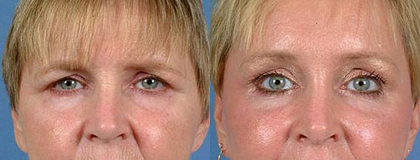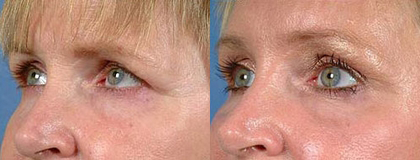
Gazing into the mirror and realizing your face is full of lines and beginning to droop is disheartening. What’s even more, considering a surgical procedure on your face can be even more frightening. Enter the endoscopic brow lift, a surgical procedure aimed at raising the brows through a small incision that is hidden in the hairline. Dr. Brad Calobrace of Louisville strongly believes in the procedure as it not only can give the lift you’re looking for in your brows, but also secondarily improve forehead lines, loose skin in the upper eyelid and even crow’s feet. When Botox isn’t enough, this may be the procedure that restores some youth in middle-aged patients.
By Brad Calobrace, MD
and Adam McMillon
The Plastic Surgery Channel
Elevating the brows with a small, hidden incision
In all facets of plastic surgery, patients are extremely concerned about the trade-off between a youthful rejuvenation for a scar. In breast augmentation, scars can be hidden and made minimal, but even if they aren’t, at least they’ll only be seen when naked. Scar concerns are most potent when facial surgery is entertained. Patients want to restore youthfulness to their face, but at what cost? Will I have a visible scar on the most visible part of my body?
When Botox isn’t getting the job done anymore, surgery is the next step. Before braving a bigger procedure like a facelift, patients have the option to do an endoscopic brow lift, a procedure aimed to rejuvenate the upper portion of the face through small incisions that are hidden in the hair. “An endoscopic brow lift is a maneuver to elevate the brow and make the aesthetics of the forehead and brow look better,” says Dr. Calobrace. “Sometimes we use Botox to take away the wrinkles on the forehead…but sometimes people want something more surgical, and Botox only does part of the story.”
A normal brow lift involves a much larger incision across the scalp, a trade-off patients are possibly unwilling to make. The difference between a typical brow lift and an endoscopic brow lift is a smaller incision that can be hidden more readily. “We didn’t like brow lifts so much because it usually involved an incision across the entire scalp,” says Calobrace. “It looked sort of Frankensteinish. With the endoscopic brow lift, it allows us to use small incisions only in the hair-bearing region of the scalp.”
When does a patient need to consider a brow lift?
“One of the heralding signs is somebody that has a lot of wrinkles in their forehead,” notes Calobrace. “That means they’re lifting their eyebrows a lot and for a good reason: their brows are low. You see those patients who have sleepy eyes… they need the brows elevated. You don’t want to take eyelid skin out even if it looks like they have too much; it’s just because the brows are too low! The first thing we want to look at is are the brows in an appropriate position. If they aren’t, then we need to elevate them.”
While the procedure is called an endoscopic brow lift, more than just the brows get improved. By lifting the brows ever so much, eyelid skin, forehead wrinkles and crow’s feet all see an improvement. “What I like about it is you get a lot of aesthetic change,” says Calobrace. “It improves the 11’s between the eyebrows… those frown lines. It softens and/or eliminates the lines across the forehead. You want the brow in a better position so it has that arch you’re looking for. It also cleans up the upper eyelid because all that skin that was drooping is elevated up. Finally, it can even improve crow’s feet.”
The procedure sounds promising, but what about recovery?
Besides worrying about surgery and the idea of a visible scar, patients want to know about recovery. When you get a great result from a board certified plastic surgeon, you’re happy, but you now have to reenter your own life…how long will that take? “The recovery for an endoscopic brow lift is pretty quick, I would say most patients can take about a week off work and get back at it,” says Calobrace. “Swelling and bruising is what holds you back; there are no incisions visible, they’re all in the hair, so it’s simply just waiting for some of the swelling to go away so you feel presentable out in public.”
“Out of one small procedure where all the incisions are in the hair-bearing regions of the scalp, not visible at all, you get an amazing aesthetic improvement.”

















Facebook
Twitter
Instagram
YouTube
RSS